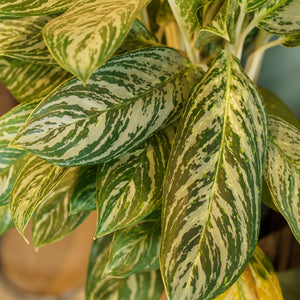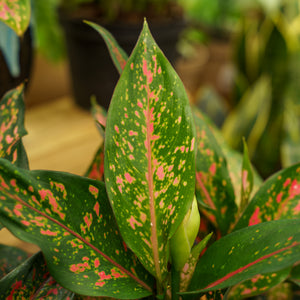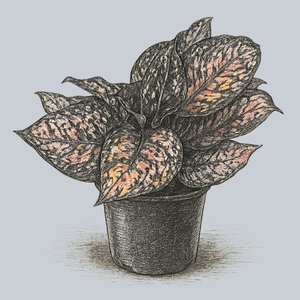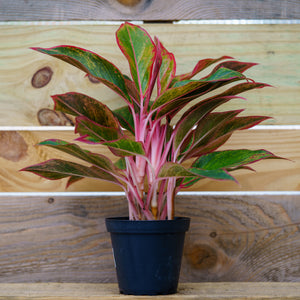The Aglaonema Guide
Aglaonema, commonly known as Chinese Evergreen, is a popular group of tropical foliage plants prized for their striking leaves, low-maintenance care requirements, and adaptability to indoor environments. Native to the tropical and subtropical forests of Asia, these hardy plants thrive in low-light conditions, making them an excellent choice for homes and offices. With a variety of leaf colors ranging from deep green to silver, red, pink, and even gold, Aglaonema adds vibrant beauty to any indoor space. Here’s everything you need to know about growing and caring for Aglaonema.

About
Aglaonema belongs to the Araceae family and includes several dozen species, many of which have been cultivated into unique and colorful hybrids. The plant's broad, lance-shaped leaves display eye-catching patterns, including speckled, striped, or variegated foliage in shades of green, white, cream, red, and pink. Chinese Evergreens are slow-growing perennials that can thrive in low to medium indirect light, making them ideal for dimly lit interiors where other plants might struggle.
Beyond their aesthetic appeal, Aglaonema plants are known for their air-purifying qualities, helping to remove toxins such as formaldehyde and benzene from indoor spaces. They are also relatively pest-resistant and require minimal care, making them a great option for beginner plant owners. Popular cultivars include Aglaonema 'Red Valentine', known for its pink-tinged leaves, Aglaonema 'Golden Madonna', with striking green and gold variegation, and Aglaonema 'Spring Snow', which features elegant silver-speckled foliage.
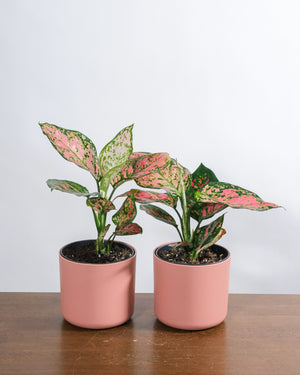
PLANTING
- USDA Hardiness Zones: While primarily grown as an indoor plant, Aglaonema can be grown outdoors in Zones 10-12 where temperatures remain warm year-round.
- Light Requirements: Prefers low to bright indirect light. Variegated varieties with colorful foliage may need more light to maintain their vibrant hues, while solid green types can tolerate lower light conditions.
- Soil: Well-draining potting mix with added perlite or sand to enhance aeration. A mix designed for aroids works well.
- Temperature: Thrives in temperatures between 65-80°F (18-27°C). Avoid exposure to cold drafts, air conditioning vents, or sudden temperature changes.
- Planting Time: Aglaonema can be planted or repotted at any time of year, though spring and summer are ideal for faster root establishment.
- Spacing: When planting multiple Aglaonema in a container or garden setting, ensure at least 12-18 inches of space between plants to allow for healthy growth.
To plant Aglaonema, choose a well-draining pot with drainage holes. Fill the pot halfway with a suitable potting mix, place the plant in the center, and backfill with soil until the roots are covered. Water thoroughly and allow excess water to drain before placing the plant in its desired location.
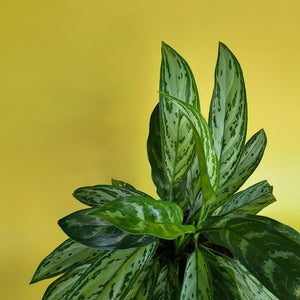
CARE
- Watering: Water when the top 1-2 inches of soil feel dry. Overwatering can lead to root rot, so ensure the pot has good drainage. Reduce watering frequency in winter when growth slows.
- Humidity: Prefers moderate to high humidity but adapts well to typical indoor conditions. Occasional misting or placing a pebble tray with water nearby can help maintain humidity levels.
- Fertilizing: Feed with a balanced liquid fertilizer every 4-6 weeks during the growing season (spring and summer). Reduce feeding in fall and winter.
- Pruning: Remove yellowing or damaged leaves as needed to keep the plant looking tidy. Pruning also encourages new growth.
- Repotting: Repot every 2-3 years or when the plant outgrows its container. Choose a pot one size larger and refresh the soil for continued growth.
- Pests & Diseases: Generally resistant to pests, but may occasionally attract mealybugs, spider mites, or scale insects. Wipe leaves with insecticidal soap or neem oil if needed.

HOW TO USE
Aglaonema’s adaptability and decorative foliage make it a versatile addition to any indoor space:
- Houseplants: Perfect for brightening up offices, living rooms, bedrooms, and hallways with minimal maintenance.
- Low-Light Spaces: Green-leaved varieties, such as Aglaonema 'Narrow Spinel', thrive in low-light environments like bathrooms or shaded corners.
- Statement Pieces: Colorful hybrids like Aglaonema 'Siam' and Aglaonema 'Jazzed Gems 'Garnet Coltrane' bring vibrant pops of color to desks, shelves, and plant stands.
- Air Purifiers: Place in frequently used indoor spaces to improve air quality and reduce pollutants.
- Container Arrangements: Combine with other low-maintenance houseplants like pothos, snake plants, or ZZ plants for a varied indoor garden display.
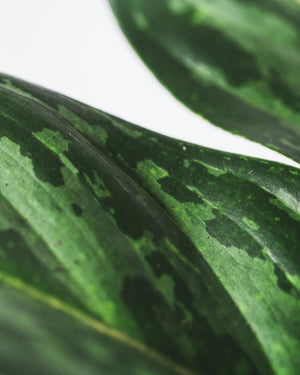
Common Questions
- Is Aglaonema toxic to cats? Yes, Aglaonema is toxic to cats. If ingested, it can cause irritation, drooling, and digestive discomfort due to calcium oxalate crystals.
- How to propagate Aglaonema? Aglaonema can be propagated through stem cuttings or by dividing the plant during repotting. Place stem cuttings in water or moist soil until roots develop.
- Is Aglaonema toxic to dogs? Yes, Aglaonema is also toxic to dogs. Ingestion may lead to similar symptoms as in cats, including mouth irritation and upset stomach.
- Do Aglaonema flower? Yes, Aglaonema produces small, inconspicuous flowers similar to those of peace lilies, but they are often removed to direct energy toward foliage growth.
- Why is my Aglaonema drooping? Drooping can be caused by underwatering, overwatering, or sudden temperature changes. Check soil moisture and adjust watering accordingly.
- How to care for Aglaonema? Provide bright, indirect light, water when the soil is dry, maintain moderate humidity, and fertilize occasionally to keep the plant healthy.
- How often to water Aglaonema? Water every 7-10 days, allowing the soil to dry between waterings. Adjust based on humidity and temperature.
Conclusion
Aglaonema is a stylish and low-maintenance houseplant that enhances indoor spaces with its striking foliage and adaptability. Whether you prefer the classic green varieties or the bold red and pink hybrids, this tropical beauty brings elegance and air-purifying benefits to any home or office. With easy care requirements and long-lasting appeal, Aglaonema remains a favorite among plant enthusiasts of all levels. Explore our selection, including Aglaonema 'Red Valentine', Aglaonema 'Golden Madonna', and Aglaonema 'Spring Snow', to find the perfect variety for your space.
The Aglaonema Collection
Sold Out
Sold Out
Sold Out
Sold Out
Sold Out

